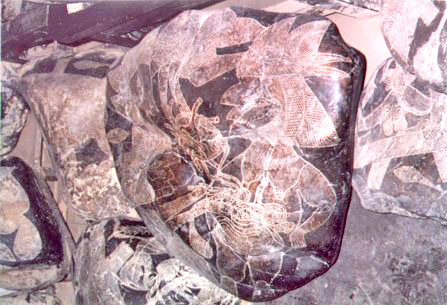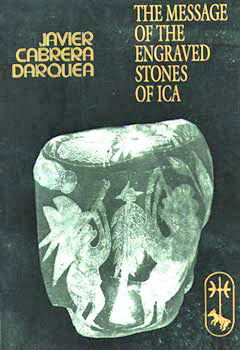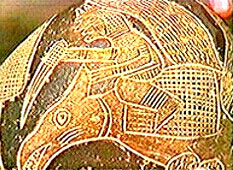|
by Philip Coppens This article originally appeared in Fortean Times 151, October 2001
from
PhilipCoppens Website
It was the 42nd
birthday of a local physician, Dr Javier Cabrera Darquea and his old
friend, photographer Felix Llosa Romero, had presented him with a
seemingly innocent gift - a curiously marked stone.
They
showed Cabrera thousands of similarly-marked stones found in the
nearby Ocucaje region and told him that they had repeatedly failed
to interest archeologists in investigating the area. Cabrera bought
341 stones from them for the equivalent of UK£30.
By the late 1970s, Cabrera estimates, he had over 11,000 of
these anomalous engraved stones.
Here, too, are depictions that challenge the accepted view of the history of life on Earth.
They show people interacting with extinct animals; hunting and domesticating a variety of dinosaurs, in particular the brontosaurs, Tyrannosaurus rex, stegosaurs and flying pterodactyls. According to connoisseurs, the real gem of the dinosaur series is a scene in which men use hand-axes to kill a dinosaur.
What impresses, they say, is that the hunters seem to display a knowledge of the animal’s anatomy in chopping at a critical nerve centre in the dinosaur’s spine that would inflict a quick and sudden death.
Cabrera’s medical career was distinguished - he’d retired as professor and head of the Department of Medicine at the University of Lima - so it is natural that, at first, he kept quiet about his ‘dinosaur stones’, preferring to draw attention to those that displayed advanced scientific knowledge, such as the astronomical and medical images.
The ‘surgery stones’ imply - if you believe Cabrera’s supporters - that the makers possessed an advanced knowledge of medicine millions of years before the earliest modern civilization, for here, in gory detail, are scenes of heart, liver and kidney transplants, a cesarean-section, brain operation, sophisticated equipment, acupuncture and genetic engineering.
In short, this highly controversial ‘library in stone’
is an archeological anomaly - a prime example of what the fortean
pioneer Ivan Sanderson called ‘oops-art’ or out-of-place
artifacts.
Predictably, the Ica
artifacts shot up the hit parade of the ‘ancient astronaut’ school,
which enthusiastically embraces any discovery that can be used to
suggest that a highly-developed ancient culture existed where none
was supposed to; and the more bizarre or anomalous the discovery,
the more likely it was, in their view, to have extraterrestrial
origins.
More recently, Creationists - who place biblical ‘truth’ above Darwinian theory - have used the Ica stones to substantiate their beliefs that the ‘behemoth’ of the Book of Job is, in fact, a dinosaur. 1
Rejecting the mooted antiquity of the stones, they
believe the stones show, instead, that dinosaurs survived into
relatively modern times, co-existing with early man, and offer proof
of the Genesis account of the Creation some six millennia ago.
For example, if humans existed that far back,
how did they survive the several global cataclysms that contributed
to the demise of the dinosaurs and huge percentages of other extant
life-forms? If dinosaurs lived into the Modern Era, why did they
suddenly disappear? 2
It was over… or was it?
When dealing with controversies of this sort, nothing is ever simple. Believers in the antiquity of the stones claimed that the farmer admitted to the hoax for a very simple reason: if the stones were genuine, he had been selling government possessions. Peruvian law dictates that archeological discoveries should be turned over to the government and he faced prison if found guilty.
By admitting it was a simple hoax, the farmer was let off the hook… and was able to provide his family with an income. When von Däniken visited the farmer in 1973, Uschuya confirmed to him that he had faked the stones; but later on, in an interview with the German journalist Andreas Fischer, Uschuya claimed the opposite.
They were genuine, he insisted, and he
admitted to a hoax to avoid imprisonment.
The Soldis’ interest began in 1961 when, according to Herman Buse, the Ica River flooded and,
Also interested in the objects was an architect, Santiago Agurto Calvo, then rector of the Universidad Nacional de Ingenieria, who bought many and, in 1966, began excavating pre-Inca tombs around Ocucaje.
In an article that year, he described the designs as
In 1968, Calvo donated a great number of
engraved stones to the Ica museum but failed to have the province’s
cultural department declare the Ocucaje region a special preserve to
prevent the illegal removal of ancient objects.
The curator of the Ica museum accepted Calvo’s collection at first as examples of pre-Inca burial art, but they were withdrawn from open display in 1970, when Cabrera’s ideas gained international notoriety.
When Cabrera visited
the museum to compare his artifacts with Calvo’s, the curator said
he withdrew them because he now believed the huaqueros (grave-
robbers) had made them.
Arguing for
their genuine origins cast Cabrera into the camp of the von Dänikenites; this is both comical and ironic as von Däniken himself
has written that he believes the stones are most likely fakes.
Cabrera devoted more and more time to deciphering the images and
came to astonishing conclusions "in strange and difficult
circumstances".
These humans supposedly used a form of concentrated psychic energy with which they were able to influence celestial events, and record on their stones, the approach of a great comet.
Further, he believed
that some of the ‘machines’ depicted look like spacecraft and
probably travelled through space "without consuming fuel." Other
designs echoed the great images laid out on the plains of Nazca - so, he concluded that Nazca really was an ancient spaceport.
He believes he has come to know what they are saying.
According to him, Gliptolithic Man came to Earth to genetically engineer the ancestors of the human race and left Earth before the impact of the Great Comet 65 million years ago, leaving their intellectual legacy on indestructible stones.
Cabrera theorized that they took off from the Nazca plains - their craft fired from electromagnetic launchers - to travel to a planet in the Pleiades.
Some of the stones, he says, show the hemispheres
of that distant planet as well as other places in the Universe where
life existed… which would imply a fair bit of space traffic prior to
the catastrophe.
For example, even if we assume they are
genuine and millions of years old, they do not necessarily contain
the type of information Cabrera maintains; the heart and brain
transplants could just as well be mutilations or acts of
cannibalism; and the "flying machines" resemble birds more than
high-tech craft. The American archeologist-publisher David Hatcher
Childress said, half in jest, that the scene showing ancients using
telescopes could equally show them playing a game of prehistoric
tennis. 5
Neil Steede - an independent archeologist and director
of the Early Sites Research Society - was one of its researchers
who, in 1995, travelled throughout Southern America, gathering
material for the programme. He investigated the Ica stones first
hand, but thought they should not be included in the original
documentary because they did not add any scientific weight to the
debate.
When Steede met Basilo Uschuya, the farmer confirmed that he had engraved the stones from drawings that Cabrera had brought to him.
Why?
Uschuya stated that Cabrera had about
5000 ‘genuine’ stones - ie. stones that Uschuya himself had
not made - and that he had not fabricated all of the others,
contrary to what he had previously stated. We have no clues as to
who else might be making these stones.
Doubters will argue that Cabrera only confessed to his part in these forged stones when faced with his accomplice’s statement - so how can we rely on any of his other statements? We also wonder whether Cabrera had asked anyone else to fabricate stones. Cabrera continues to maintain that his stones are genuine and that there is still a hoard of genuine stones, whose secret location is guarded by Uschuya and others.
Cabrera claims he was shown a cave in which the cache of stones had remained hidden for millions of years. This cave was revealed, he says, after a severe rainstorm washed open a new area near the Ica river. (This may or may not be the event referred to by Herman Buse in 1965.)
Cabrera remains
tight-lipped on who took him to the cave and as no maps or pictures
of it exist we have only Cabrera’s word for it. Cabrera has stated
that he hopes it will not be found. Even Erich von Däniken, who
describes Cabrera as a "warm friend", was denied the privilege. Steede, who offered to be blindfolded throughout the journey to the
cave, was also rebuffed and now believes the cave never existed.
Unfortunately, though some testing was done, the
results remain inconclusive. Cabrera himself sent stones to the
Universities of Lima (Peru) and Bonn (Germany) and to NASA scientist
(and ancient astronaut buff) Joseph Blum. At Bonn, a Professor Frenchen apparently confirmed that the stones were andesite (an
extremely hard volcanic rock composed mostly of silica) and that the
oxidized patina on their surface indicated "significant" age.
The stones were indeed andesite, worn smooth in ancient rivers.
Cabrera adds, specifically, that,
This would suggest the stones were indeed ancient. However, this has to be balanced by the first-hand observation by Neil Steede that, even though the stones he examined did have this patina, there was no patina in the grooves. This suggests that while the stones were certainly very old, the carvings were clearly of far more recent origin.
Furthermore, they are
restricted to depicting conventional humans and existing animals,
not extinct animals; nor do they include any examples of the more
exotic motifs of the Cabrera stones.
The team had filmed secretly as
Cabrera took them
into one of his ‘secret’ rooms. Here, instead of incised stones,
were astonishing clay sculptures: small dinosaurs crawling out of an
egg, kangaroos, people with odd-shaped heads and other similar
themes. The team decided to confront Basilo Uschuya with this new
footage. He claimed to have made these sculptures as well, for what
in his opinion was a minimum salary, and showed the team such a
sculpture, which seemed indistinguishable from those in Cabrera’s
secret room.
The point is that, unlike the stones, these clay figurines can be tested. Von Däniken sent one to the University of Zurich for carbon-dating and they reported that the figurine was modern.
His
fellow researcher, Johannes Fiebag, sent two other samples to the
University of Weimar who, likewise, concluded that the samples were
"relatively young" and still contained water. Conclusion: these
figurines were not "a hundred thousand" years old, as Cabrera
claimed; they could have been made 20 years ago.
An alternative explanation - not
considered by Cabrera or others - is that the engravings are votive
renderings by the tribe’s shaman; after all, the dream-flight of the
shaman is, in many cultures, linked to the flight of birds. Could
not a shaman have picked up a dinosaur bone (which can be found
easily in the area), entered a trance, connected with the bone’s
previous owner and seen the dinosaur age in a vision?
The one researcher who has known Cabrera the longest, Erich von Däniken, has repeatedly stated that some stones are definitely fakes. He has also cast doubt on the origins of the entire collection. In the end, perhaps von Däniken understands Cabrera’s motive best.
He is convinced Cabrera tells stories:
Cabrera’s interest in medicine and archeology might have made him susceptible to an ingenious fraud, but if so he is not the one who has profited from it.
Or perhaps he has fooled himself, seeing evidence of his wishful thinking everywhere. In 1966, the media were rife with the theme of men and dinosaurs interacting, especially in the movie One Million Year BC (1966).
Was Cabrera inspired by this?
Or was he inspired by the so-called ‘Acambaro figurines’, named
after their place of origin in Mexico where, in 1925, Waldemar
Julsrud, a Danish storekeeper, found hundreds of clay figurines of
dinosaurs which - like their Ica counterparts some 40 years later - are cavorting with men? 9 Clearly, more research must be done to
settle the doubts about the Ica stones.
Tony Morrison and Ray Sutcliffe, who specialize in film reportage from South America, were chiefly interested in ancient trackways and the Nazca lines, but included the mystery of the Ica stones. Morrison - who has visited Peru on a regular basis since 1961 - went on to write the book Pathways to the Gods (1978).
He was told by local informants that, despite the esteem with which Cabrera was originally regarded, his ‘crazy’ ideas had isolated him and created some bad feeling in the community Sutcliffe told FT that they had located and filmed Basilo Uschuya, the only forger of the stones ever identified.
Uschuya’s homestead stood out from those surrounding it as the only one with a TV mast and an electricity generator. Far from being an illiterate peasant, Sutcliffe said Uschuya was intelligent, proud of his achievement and had "a great sense of humour."
He proved it to the TV crew by taking a fresh stone about an inch a half long - its patina the result of being baked in cow dung and massaged with boot polish - powered up his dentist’s drill and carved an ‘ancient’ legend of ‘BBC TV’.
Today,
the stone sits on Sutcliffe’s desk as one of the most unusual
paperweights in the world.
|


 The
earliest Peruvian artifacts seem to date back to around 20,000 years
ago, and discoveries of engraved stones in the Ica region go back to
Spanish records of the mid-15th century.
The
earliest Peruvian artifacts seem to date back to around 20,000 years
ago, and discoveries of engraved stones in the Ica region go back to
Spanish records of the mid-15th century.  In
1977, two producers for BBC TV travelled to Peru to film a number of
stories for a programme called ‘Pathways to the Gods’, in the
Chronicle series.
In
1977, two producers for BBC TV travelled to Peru to film a number of
stories for a programme called ‘Pathways to the Gods’, in the
Chronicle series.